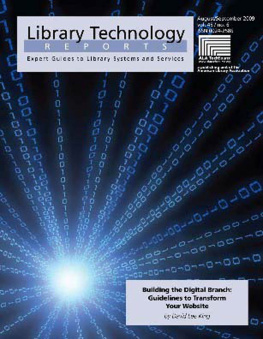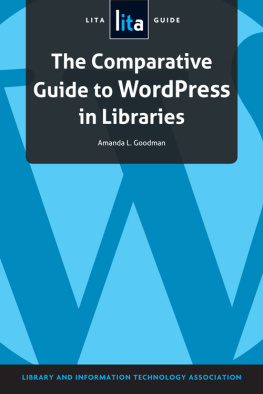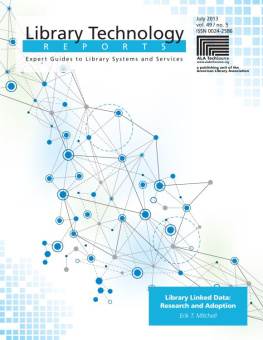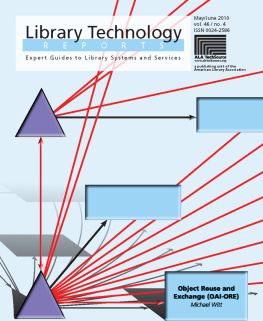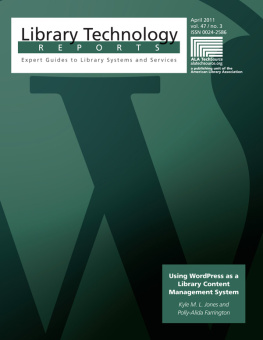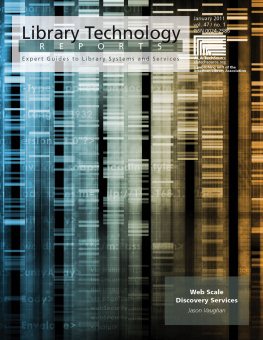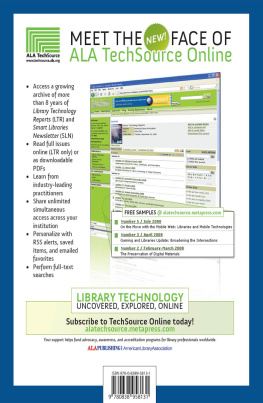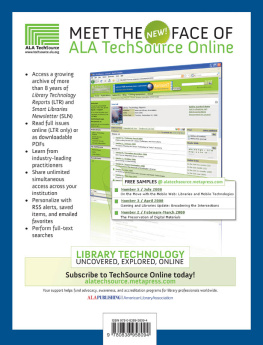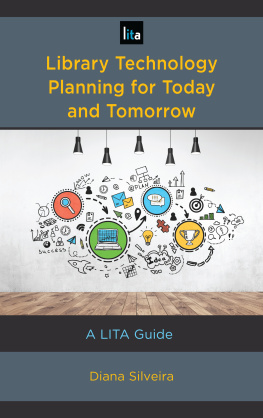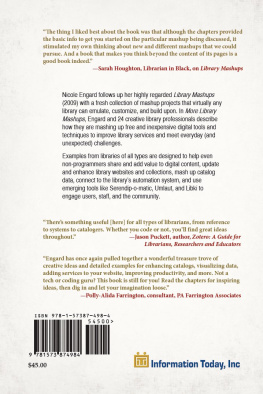Library Technology
R E P O R T S
American Library Association
50 East Huron St.
Chicago, IL 60611-2795 USA
www.alatechsource.org
800-545-2433, ext. 4299
312-944-6780
312-280-5275 (fax)
Advertising Representative
Brian Searles, Ad Sales Manager
ALA Publishing Dept.
312-280-5282
1-800-545-2433, ext. 5282
ALA TechSource Editor
Dan Freeman
312-280-5413
Copy Editor
Judith Lauber
Administrative Assistant
Judy Foley
800-545-2433, ext. 4272
312-280-5275 (fax)
Production and Design
ALA Production Services: Troy D. Linker
and Kimberly Saar Richardson
Library Technology Reports (ISSN 0024-2586) is published eight times a year (January, March, April, June, July, September, October, and December) by American Library Association, 50 E. Huron St., Chicago, IL 60611. It is managed by ALA TechSource, a unit of the publishing department of ALA. Periodical postage paid at Chicago, Illinois, and at additional mailing offices. POSTMASTER: Send address changes to Library Technology Reports, 50 E. Huron St., Chicago, IL 60611.
Trademarked names appear in the text of this journal. Rather than identify or insert a trademark symbol at the appearance of each name, the authors and the American Library Association state that the names are used for editorial purposes exclusively, to the ultimate benefit of the owners of the trademarks. There is absolutely no intention of infringement on the rights of the trademark owners.

www.alatechsource.org
Copyright 2009 American Library Association
All Rights Reserved.
About the Author

David Lee King is the Digital Branch and Services Manager at the Topeka and Shawnee County Public Library, where he plans for, implements, and experiments with emerging technology trends. He speaks internationally about emerging trends, website usability and management, digital experience planning, and managing techie staff and has been published in many library-related journals. David was named a Library Journal Mover and Shaker for 2008 and recently published his first book, Designing the Digital Experience. David writes the Internet Spotlight column in Public Libraries magazine with Michael Porter and maintains a blog at www.davidleeking.com.
Abstract
In the past fifteen years, the World Wide Web has become such a major part of the library world that most libraries now have some presence on the Web. This issue of Library Technology Reports explores the idea of the digital brancha library website that is a vital, functional resource for patrons and enhances the librarys place within its community. The report outlines an efficient process for creating a digital branch, from the initial phases of gathering information and sketching out a design, to winning approval from management, hiring qualified IT staff, and maintaining and upgrading the site once it is built. Throughout the report, the author regularly uses his experience at his own library as an example of how the process can unfold and what pitfalls to avoid.
Subscriptions
For more information about subscriptions and individual issues for purchase, call the ALA Customer service Center at 1-800-545-2433 and press 5 for assistance, or visit www.alatechsource.org.
Table of Contents
What Is a Digital
Branch, Anyway?
Abstract
In order to build a digital branch, we first need to know what a digital branch is. How does it differ from a website? This chapter of Building the Digital Branch: Guidelines for Transforming Your Library Website gives a brief history of library websites and discusses how library websites and the traditional physical library combine to form the concept of a digital branch.
Library wedbsites have been around for about fifteen years. During that time, library websites and the nature of the Internet itself have changed considerably. These sites started to appear in the mid-nineties. Dan Lester, librarian emeritus at Boise State University, described those early days: Boise State University Library had a website in the spring of 1994. It ran under Windows 3.1 on my desktop on a 486, 24/7, and was able to easily handle the load in those days. I also started building websites around that time.
The list of what has changed in the past fifteen years could fill a library. For starters, coding languages have multiplied. Back then, I learned HTML. Now, Web developers also learn CSS, JavaScript, PHP, Ajax, and Ruby on Rails (and those are just a few).
Interaction has also changed. The old Web is described in the definition of World Wide Web on Wikipedia as a place where one can view Web pages that may contain text, images, videos, and other multimedia and navigate between them using hyperlinks. The old Web was primarily about finding information and navigating to other webpages. Hence, it was fondly referred to as the Information Superhighway.
Today, people driving down that road have discovered communities along the way. With the emergence of Web 2.0, people can not only find information, they can also often interact directly with the person who provided that information. They can add their own thoughts to the content created by that person. They can remix that original content into something else entirely. The superhighway has become more like the old, winding Route 66, with many points of interest. Someone might want to pull off the road and poke around or chat for a while. The new Web allows that type of interaction.
Thats where the idea of a digital branch comes into play. A modern library can exist in two placesin a building and online. When this idea is taken to the next step, people can now hold conversations with librarians in the building and online. People can hold meetings in the physical library and in the online library.
If you would like your digital branch to become more of a destination, read onwell take that journey together. In this issue of Library Technology Reports, you will find the following:
The concept of a digital branch library is defined and explained in this chapter, What Is a Digital Branch, Anyway? In , Gathering Information, I discuss how my library, Topeka and Shawnee County Public Library, gathered information from customers and staff about what they thought a digital branch library should do. Next, in the third chapter, we examine The Planning Process.
The process of building the site is discussed in , Creating Community at the Digital Branch.

